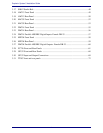
Euphonix System 5 Installation Guide System 5 Overview
10
Inputs
System 5 inputs may be mono, stereo, or any format up to 7.1, which means that a single
input may use one to eight logical channels.
Physical Faders
Each CM408 Eight-channel Module contains eight physical faders. Each fader can control
two inputs using a Swap button that switches the fader between the Swap and Main inputs.
Layouts
Inputs are assigned to physical faders by using Layouts. Numerous Layouts can be easily
stored and recalled to remap the console surface. To understand Layouts, consider the fol-
lowing examples:
• A console fitted with one CM408 has eight physical faders that can control up
to 16 inputs (Swap and Main per input). One Layout can assign 16 stereo inputs
to the faders for a total of 32 logical channels.
• Another Layout for the same system with eight faders can assign 7.1 inputs to
the Main and Swap layers. This yields 16 inputs each with eight channels for a
total of 128 logical channels.
• To make the situation even more interesting, these two examples can be combined!
Assuming the DSP processing is available in the DF64s, the first 32-channel
Layout can be assigned and left connected to the mix buses while the second
Layout is recalled. If none of the channels between the Layouts are the same,
there are now 160 logical channels feeding the mix buses at the same time, al-
though they cannot be controlled simultaneously from the console surface.
Layouts may also be used to place the inputs most often used on the top fader layer, or in-
puts that should be grouped together (i.e., drums).
Analog and Digital I/O
All audio signals are converted to and from the MADI format through analog and digital
converters. All MADI devices are connected to the SH612 Studio Hub which is connected
to the DF64 Digital Frames. A system may have one or two SH612s:
• one SH612: connect up to six output and eight input devices.
• two SH612s: connect up to 12 input devices to one and up to 12 output devices
to the second.
Analog I/O
All analog I/O is converted between analog and MADI formats via the AM713 Analog to
MADI Converter, and the MA703 MADI to Analog Converter. Each unit’s main I/O handles
24 signals and also contains an auxiliary stereo analog input or output, and an auxiliary stereo
digital input or output (AES/EBU and S/PDIF).


















